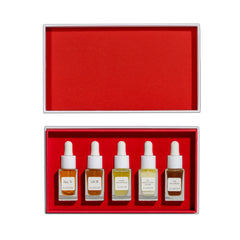Introduction
In this study I looked at the effects of hyaluronic acid serums on skin dryness.
The inspiration for this study were the following observations:
- Hyaluronic acid forms a gel when in contact with water because it pulls water from its environment
- Hyaluronic acid is not able to penetrate the epidermis once this gel is formed, and therefore sits on the skin
- A common complaint of users using HA serums is skin dryness
Objective
The goal of this study was to examine the effects of hyaluronic acid-containing skin care on skin hydration levels.
Experimental Serums
For this experiment a serum containing natural water-based extracts and 0.25% (HA0.25), 0.5% (HA0.5) and 0.75% (HA0.75) hyaluronic acid were applied to the skin (in an area not exposed to the sun) for one month.
Experimental Controls
The skin hydration levels were compared to the controls:
Control A: water
Control B: Water-based extract without HA
Comparison to Vaseline:
Skin hydration levels were compared to the hydration levels from applying the liquid extract serum (Control B) followed up with topical Vaseline (SV) applied to the skin.
Measurements
Hydration levels of the stratum corneum were measured by applying a probe to the skin after application of serums or controls and measuring the conductance of the skin. Measurements were taken once every week for 4 weeks total.
Why conductance measurements matter:
When there is a change in the water property of skin, its electrical activity also changes.
Conductance is measuring how easily an electrical current can pass through your skin. Water is a conductor of electricity. When there is more water in your skin, there is a greater ability for a current to move through.
All measurements were taken at 10AM, 2 hours after application of serum or control. Serums and controls were all maintained at room temperature and stored away from sunlight. All serums and controls were wiped off of the applied area with a wet cloth and patted dry to prevent interference with the readings.
5 total measurements were taken for each experimental or control serum and the average measurement was recorded.
Results
It was found that there was a gradual loss in skin hydration levels when using a serum containing HA. It was noted that the more HA in the serum, the greater the loss of hydration.
There was no significant changes in hydration levels for the control serums
There was a notable increase in hydration levels when the serum extract was sealed on the skin with Vaseline.

Discussion
This preliminary study shows that serums containing hyaluronic acid elicit skin-drying properties. Hyaluronic acid has the natural tendency to pull water from its environment, and when it is applied to skin it is pulling water from the skin. These results shows that for skin hydration, it is best to apply a hydrating serum without ingredients that pull water, and to seal in the serum with a topical that prevents evaporation.
Future studies will involve long-term measurements of skin dryness using the above methods in addition to using different equipment to measure skin hydration.


